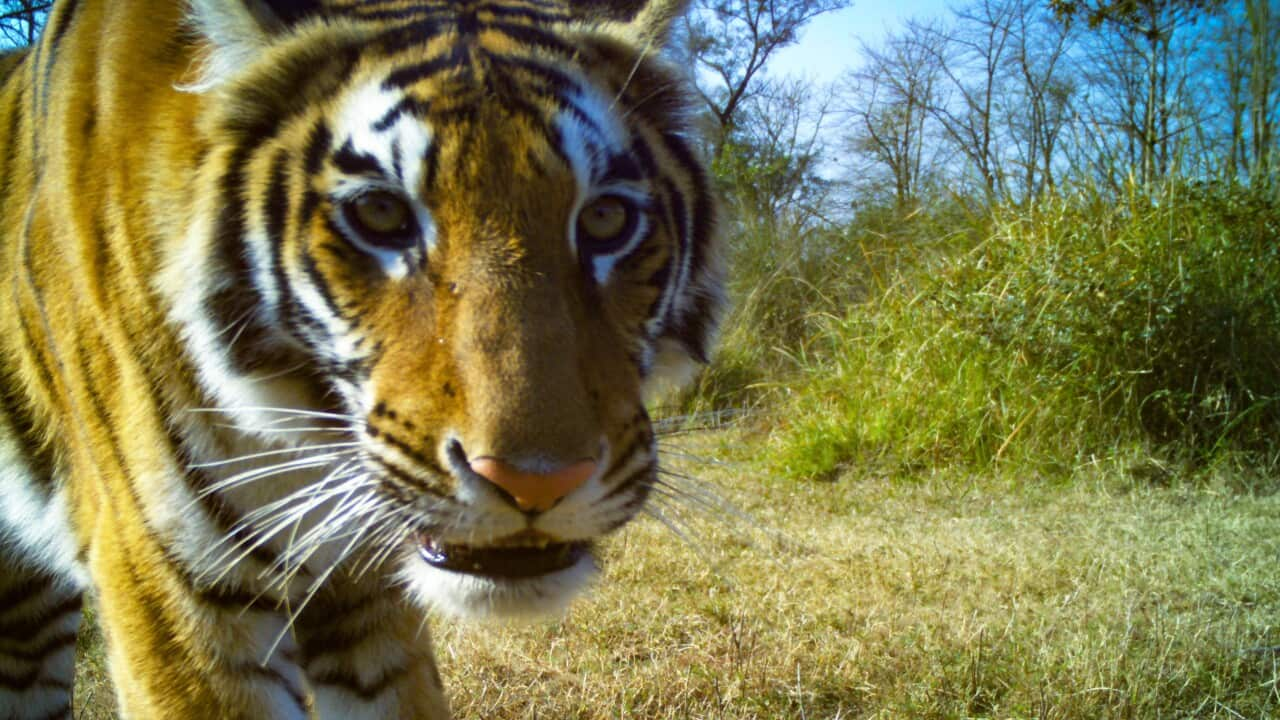Italian
Le unità dislocate qui stanno facendo la loro ginnastica mattutina, e poi queste squadre partiranno alla volta del parco per i loro pattugliamenti giornalieri.
Si tratta di sei uomini e due donne.
Stanno camminando lungo un piccolo sentiero attraverso la giungla che gira intorno al fiume e sono armati di fucile.
"You never know what's beside you, you never know what's near you so you have to be careful at all times."
Il capitano Ayush Jung Bahadur Rana è a capo di questo gruppo, una delle 31 unità dislocate nel parco.
"We are looking for any illegal encroachment of people and domestic animals. Tigers are the majestic creatures. There are two types of feeling when you come in here to help them. It's Oh my god, what a majestic creature is that? And the other feeling is, oh my god, am I dead? being assigned in protection duties, it's an honour. It's been a privilege to be part of something that is really big."
Il supervisore generale del Bardiya National Park è Bishnu Shrestra.
"I feel proud at this moment. We've got success regarding the tiger numbers. The tigers are doubling. We have created water ponds and grassland particularly for threatened species of the tiger. So we are managing the tiger in a sustainable way."
Fuori dai cancelli del parco e nei villaggi ai suoi confini, ci sono sentimenti contrastanti sulla ripresa delle tigri.
Manoj Gutam è un ambientalista e un operatore nel turismo ecologico.
"It is definitely something to be celebrated. It does not come without the cost. The community lives in terror. So there is a price that the community has paid, with the news that Nepal has successfully doubled its tiger numbers."
Samjhana l’anno scorso ha perso sua suocera per via delle tigri.
Si trovava all’interno del parco nazionale, tagliando erba per il loro bestiame quando è stata attaccata.
"Tourists come to see tigers but we live with them. We depend on the national park to collect wood and grass."
Negli scorsi 12 mesi in Nepal 16 persone sono state uccise dalle tigri.
Si tratta del doppio delle vittime totali nei cinque anni precedenti.
A giugno si sono svolte delle proteste, dopo che un leopardo ha attaccato un villaggio, una settimana dopo la morte di una donna uccisa da una tigre.
La comunità esige che le autorità facciano di più per proteggerli.
Il capitano Rana sostiene che il suo compito di proteggere sia gli uomini che le tigri stia diventando sempre più difficile.
"More number of tigers and more number of people definitely there's going to be conflict so it is going to be a challenging job for us to you know maintain peace between two species."
In un accordo firmato con la comunità locale dopo le proteste, le autorità si sono impegnate a costruire più palizzate e muri, nel tentativo di dividere gli umani dagli animali selvatici.
I responsabili stanno inoltre cercando di fornire mezzi di sostentamento diversi per chi usa il parco nazionale per raccogliere beni di prima necessità o per fare pascolare il bestiame – insieme a piani per sviluppare professionalità in modo tale che i locali possano intraprendere piccole imprese o lavorare nel turismo.
English
The units that are stationed here are doing their morning exercise, and then these teams will head out across the park for their daily patrols.
There's six men and two women.
They're walking along a small track through the jungle that winds next to the river and they're armed with rifles.
"You never know what's beside you, you never know what's near you so you have to be careful at all times."
Captain Ayush Jung Bahadur Rana [[bun-do-AH-rah-nah]] leads this group, one of 31 units stationed across the park.
"We are looking for any illegal encroachment of people and domestic animals. Tigers are the majestic creatures. There are two types of feeling when you come in here to help them. It's Oh my god, what a majestic creature is that? And the other feeling is, oh my god, am I dead? being assigned in protection duties, it's an honour. It's been a privilege to be part of something that is really big."
The Chief warden of Bardiya National Park is Bishnu Shrestra.
"I feel proud at this moment. We've got success regarding the tiger numbers. The tigers are doubling. We have created water ponds and grassland particularly for threatened species of the tiger. So we are managing the tiger in a sustainable way."
Outside the parks gates and in the villages along its borders, there are mixed feelings about the tiger recovery.
Manoj Gutam [[mah-noosh go-tum]] is a conservationist and eco-tourism operator.
"It is definitely something to be celebrated. It does not come without the cost. The community lives in terror. So there is a price that the community has paid, with the news that Nepal has successfully doubled its tiger numbers."
Samjhana lost her mother-in-law last year to the tigers.
She was deep inside the National Park, cutting grass for their cattle when she was attacked.
"Tourists come to see tigers but we live with them. We depend on the national park to collect wood and grass."
Sixteen people have been killed by tigers in Nepal in the last 12 months.
It's double the number of total deaths in the previous five years.
Protests were held in June, after a leopard raided a village a week after a woman was killed by a tiger.
The community are demanding authorities do more to protect them.
Captain Rana says his duty to protect both humans and tigers - is becoming increasingly challenging.
"More number of tigers and more number of people definitely there's going to be conflict so it is going to be a challenging job for us to you know maintain peace between two species."
In an agreement signed with the local community after the unrest, authorities have vowed to look into building more fences and walls in an attempt to divide humans and wildlife.
Officials are also looking at providing alternative livelihoods for those who use the national park to collect materials or graze cattle - with plans to develop skills so locals can start small businesses or work in tourism.




